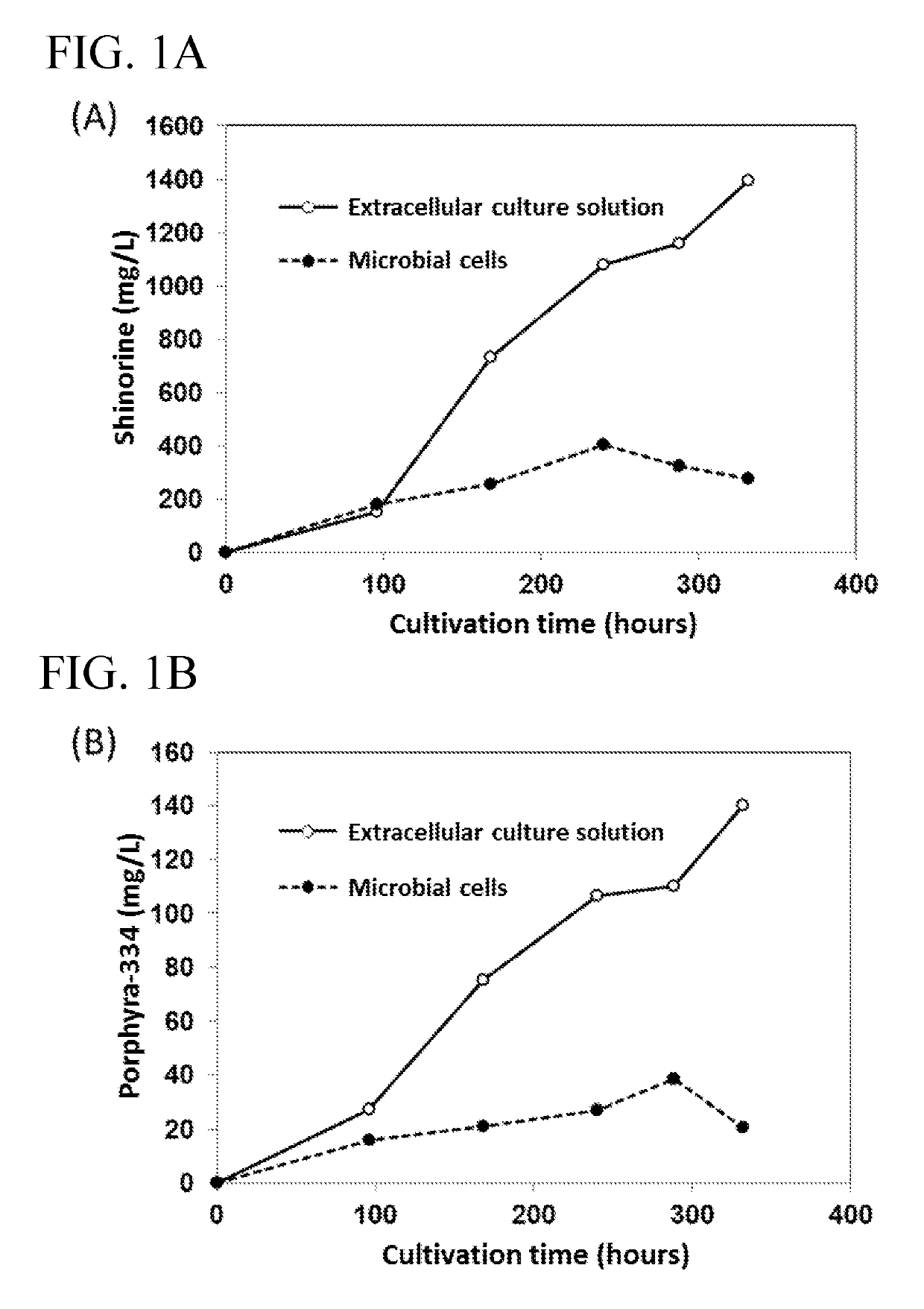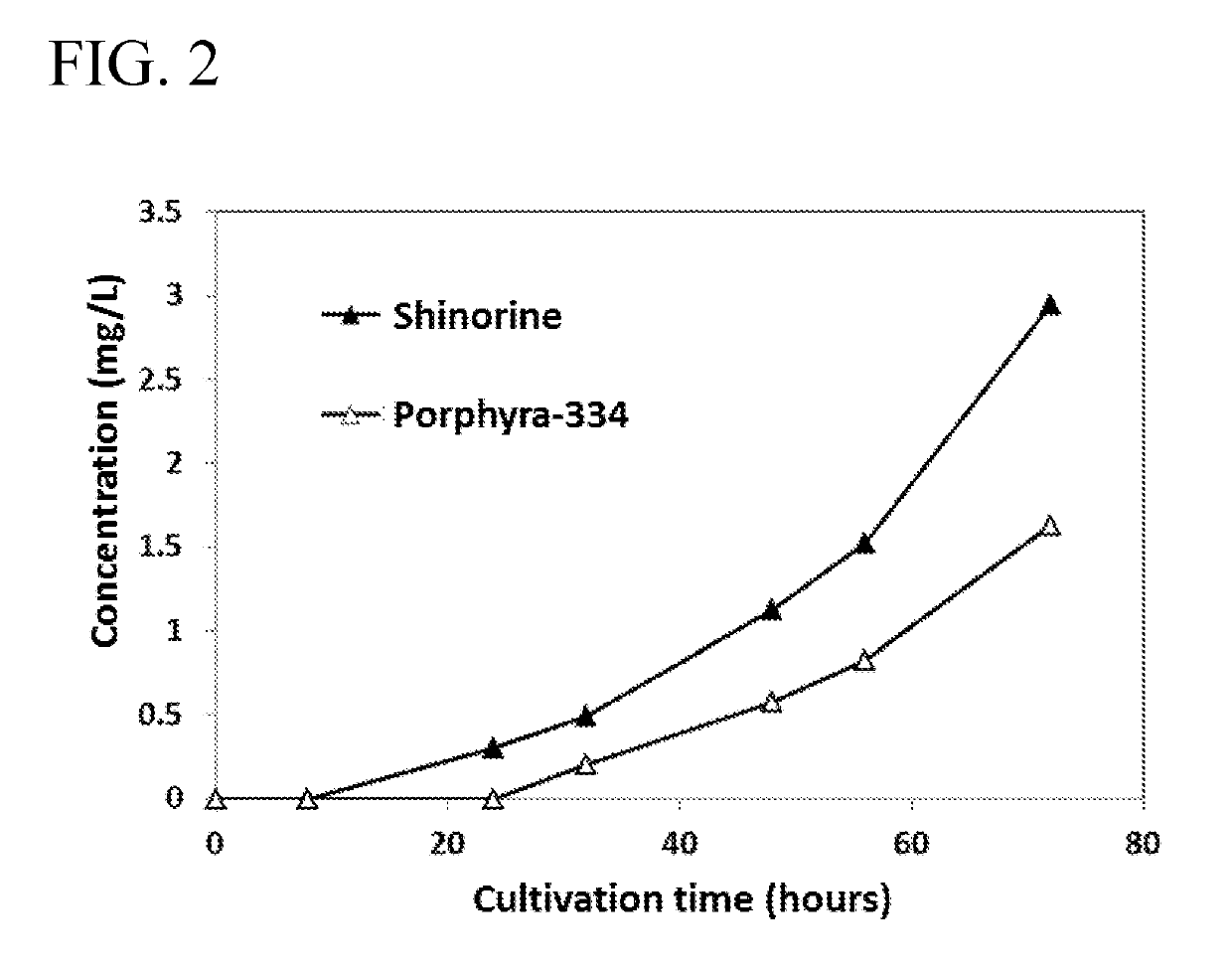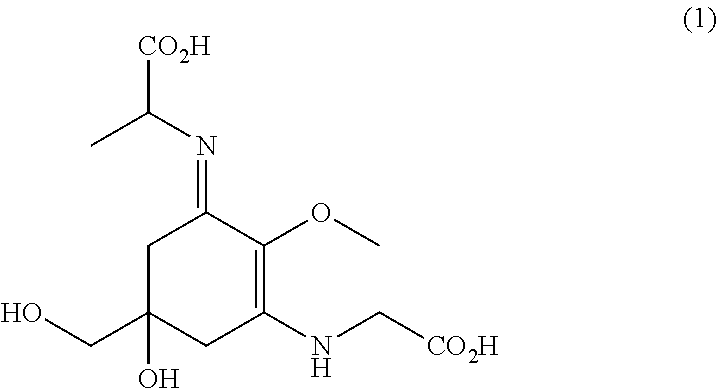Method for producing mycosporine-like amino acid using microbes
a technology of mycosporine and amino acid, which is applied in the preparation of oximes, human health protection, bacteria material medical ingredients, etc., can solve the problems of reduced elasticity, easy decomposition of ultraviolet light absorption agents, and induced early skin aging such as wrinkles and sagging, so as to achieve a more stable production and facilitate the production of maa. , the effect of reducing the number of steps
- Summary
- Abstract
- Description
- Claims
- Application Information
AI Technical Summary
Benefits of technology
Problems solved by technology
Method used
Image
Examples
example 1
[0077]1. Production of MAA using Streptomyces
[0078]The present inventors produced MAAs using Streptomyces lividans and Streptomyces avermitilis. In addition, the present inventors compared the production amount of MAA with respect to the production in extracellular culture solution and in microbial cells (FIG. 1).
[0079]1-1. Introduction of MAA Biosynthetic Enzyme Genes
[0080]1-1-1. Introduction of MAA Biosynthetic Enzyme Genes into Streptomyces lividans
[0081]As MAA biosynthetic enzyme genes, amir_4256 (SEQ ID NO: 1), amir_4257 (SEQ ID NO: 2), amir_4258 (SEQ ID NO: 3) and amir_4259 (SEQ ID NO: 4) genes derived from Actinosynnema mirum DSM43827 were used. These genes were ligated to a vector having pIJ101 ori under the control of PLD promoter (see, JP2002-51780A) to prepare a gene expression vector. Streptomyces lividans 1326 (NITE accession number: NBRC 15675) was transformed with the gene expression vector to obtain an MAA producing strain. Streptomyces lividans was transformed in ...
example 2
[0097]2. Production of Novel MAA (Mycosporine-Glycine-Alanine)
[0098]2-1. Streptomyces avermitilis producing an MAA was cultured in the same manner as in Example 1 for two weeks. The initial glucose concentration was set at 100 g / L. As a result, in the extracellular culture solution, mycosporine-glycine-alanine was produced as a novel MAA in addition to shinorine and porphyra-334. The production amount of mycosporine-glycine-alanine obtained was 25 mg / L. HPLC analysis was carried out in the conditions shown in Table 5, and as a result, the retention time was around 15 minutes.
[0099]2-2. Identification of Novel MAA (Mycosporine-Glycine-Alanine)
[0100]The novel MAA was identified as follows. Using an HPLC apparatus equipped with a photodiode array detector and an HR-MS detector, UV absorption spectrum and the accurate mass were measured. The measurement conditions of HPLC are as shown in the following Table.
[0101]
TABLE 6Column:YMC-Pack Pro C18 RS-303(5 μm, 4.6 mm ϕ× 25 cm)(manufactured ...
example 3
[0103]3. Production of MAA using Corynebacterium
[0104]The present inventors produced MAAs by using Corynebacterium glutamicum.
[0105]3-1. Introduction of MAA Biosynthetic Enzyme Genes
[0106]3-1-1. Introduction of MAA biosynthetic enzyme genes into Corynebacterium glutamicum
[0107]As MAA biosynthetic enzyme genes, amir_4256 (SEQ ID NO: 1), amir_4257 (SEQ ID NO: 2), amir_4258 (SEQ ID NO: 3) and amir_4259 (SEQ ID NO: 4) genes derived from Actinosynnema mirum DSM43827 were used. These genes were ligated to a vector having pBL1 ori, under the control of a gapA promoter (see, Appl Microbiol Biotechnol (2008) 81: 291-301) to obtain a gene expression vector. Corynebacterium glutamicum ATCC13032 (NITE accession number: NBRC 12168, deposited with International Patent Organism Depositary (IPOD), National Institute of Technology and Evaluation (NITE), located at 2-5-8, Kazusakamatari, Kisarazu-shi, Chiba) was transformed with the gene expression vector by electroporation to obtain an MAA produc...
PUM
| Property | Measurement | Unit |
|---|---|---|
| wavelength | aaaaa | aaaaa |
| concentration | aaaaa | aaaaa |
| concentration | aaaaa | aaaaa |
Abstract
Description
Claims
Application Information
 Login to View More
Login to View More - R&D
- Intellectual Property
- Life Sciences
- Materials
- Tech Scout
- Unparalleled Data Quality
- Higher Quality Content
- 60% Fewer Hallucinations
Browse by: Latest US Patents, China's latest patents, Technical Efficacy Thesaurus, Application Domain, Technology Topic, Popular Technical Reports.
© 2025 PatSnap. All rights reserved.Legal|Privacy policy|Modern Slavery Act Transparency Statement|Sitemap|About US| Contact US: help@patsnap.com



